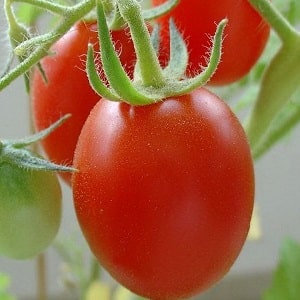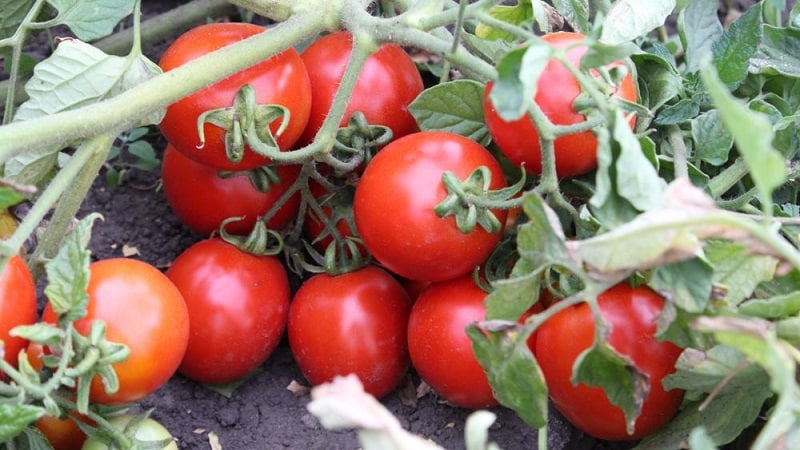A gift from Siberian breeders - tomato “Countryman”: description of the variety and rules for growing it
Growing tomatoes at your own dacha is a difficult and interesting task in its own way. The choice of variety is always a pressing issue for every summer resident: it is important that the planting material has good germination, and that the crop itself does not get sick and produces a high yield.
In the article we will look at the advantages and disadvantages of the Zemlyak variety, and also share reviews from gardeners about its cultivation.
Description of the variety
The variety appeared thanks to the developments of Siberian breeders. Russian scientists specially created it for cultivation in vast areas with a temperate continental climate and in the Siberian region.

Distinctive features
Tomato Countryman is grown in open ground, using seedlings or seeds. It belongs to early-ripening determinate plants, that is, it is a compact, low-growing bush that grows up to 70 cm in height.
Important! There is no need to tie up this nightshade crop. In addition, there is no need to remove stepsons.
Fruit characteristics, yield
Up to 15 tomatoes can ripen on a tomato bush.. In general, the yield of one plant is about 4 kg of fruit. The first tomatoes ripen approximately three months after planting the seedlings in the ground. Fully ripen in July.
Tomato fruits Zemlyak distinguished by their rich red color and oblong smooth shape. Their sizes are approximately the same, the weight of one copy is 60-80 g.Due to the fact that inside one tomato there are no more than 2-3 chambers, it is classified as a small-chambered nightshade.
Fruits of culture have a sweet and sour taste and dense pulp. They are transportable and reliable in storage. This is an excellent raw material for canning whole fruits and preparing low-calorie vegetable dishes.
How to grow
Taking into account the characteristics of the temperate continental climate, to grow tomatoes of the Zemlyak variety preferably in seedlings. In warmer regions, seedless sowing can also be considered.
Read also:
Planting with seeds/seedlings
Stages of planting seeds:
 Process open ground. The soil is dug up with a bayonet shovel, pitchfork or motorized plow (cultivator), after which it is loosened and mineral fertilizers are applied.
Process open ground. The soil is dug up with a bayonet shovel, pitchfork or motorized plow (cultivator), after which it is loosened and mineral fertilizers are applied.- The soil layer is watered with water and covered with plastic film.
- After a thorough and prolonged warming of the earth, the seeds are planted in open ground. Planting material must be dry or pre-moistened. To soak, the seeds are placed in a wet cloth and left for several days in a room at room temperature. As an alternative, soaking for 2-3 hours at a temperature of +26 °C is considered.
Approximate immersion depth - 1-2 cm. It is advisable to place at least two seeds in each hole with a distance of 2-3 cm. The buried holes are watered with warm water and covered with polyethylene. In the daytime, the film must be folded upward, otherwise the sprouts that have emerged may burn.
Seedling method
For seedlings take disinfected low containers.
Important! Containers made of plastic, wood, paper (cardboard), peat and others are acceptable.
They are filled with disinfected soil mixture, consisting of peat, garden soil, compost, sand and ash in a ratio of 2:1:1:0.5. Ash is taken at the rate of 200 g per 10 kg of soil.
Two months before planting young shoots in open ground the seeds undergo a selection procedure and testing for germination, after which they are buried in the ground in the same way as with the seedless method. Feeding and watering the plant are required.
Half a month before transplantation, the sprouts are hardened (upon reaching a stable above-zero temperature):
- open the windows - first for an hour, then for a longer period;
- take it out onto the balcony for a short period of time, gradually increasing the time the plants spend in the air;
- continue to grow outdoors - first in the shade, then in the sunny side.
When planting seedlings in the ground There should be a distance of 35 cm between bushes, and at least 70 cm between rows.

Care
To help plants grow healthy and strong, it is important to do the following regularly:
- water;
- weed;
- loosen;
- mulch;
- feed;
- thin out.
Important! Water about once a week at the rate of one bucket of water per bush. If there is no rain in the region, but there is heat and drought, water 2-3 times a week.
 It is preferable to feed the plant liquid solutions 2-3 times during the entire growth period. The composition of fertilizers depends on the stage of development. At the initial stage, the soil is fertilized with nitrogen substances. They promote the growth of shoots and leaves.
It is preferable to feed the plant liquid solutions 2-3 times during the entire growth period. The composition of fertilizers depends on the stage of development. At the initial stage, the soil is fertilized with nitrogen substances. They promote the growth of shoots and leaves.
In the future, summer residents add potassium and phosphorus compounds. Hydrogen peroxide, yeast, ash, etc. give excellent results.
Weed control is an important part of care. Weeds are removed using agricultural hand tools and special mechanized equipment, and poisons. Weeding allows you to remove both the above-ground and underground parts of the weed. As a result, the grass will not take vital components from the tomatoes and will not disrupt their growth.
During the mulching process the ground between the bushes is covered with dried grass, sawdust, straw and other alternative means.
Important! This method will retain soil moisture and protect the bush from dehydration. As a result, soil properties improve as the fertility of the substrate increases.
Features of cultivation and possible difficulties
A distinctive feature of growing Countryman is Watering only after sunset.
It is important to monitor the sequence of fertilizing. Compounds that help at one stage of development cause harm at another stage of growth.
Potential difficulties may arise if the farmer has not taken the soil composition into account. Soils with high acidity will not produce high yields - all efforts will be in vain.

Diseases and pests
Nightshade culture The following diseases may affect:
- Late blight. Looks like dark dots. It is treated with copper sulfate and factory-made preparations containing copper.
- White and gray rot. Light, dry spots form on the plant. To eliminate the disease, it is necessary to reduce humidity, improve ventilation and use antifungal agents.
- Dry or zonal spotting. Looks like necrotic spots. The destroyed plants are destroyed and henceforth the rules of crop rotation are followed.
- Wilt. The infected plant is removed from the soil and destroyed. The well is treated with a solution of copper sulfate.
- Apical rot. It occurs due to improper plant care, incorrect soil composition, and improper feeding with mineral fertilizers. The disease is treated and prevented with the drugs “Zircon”, “Humifid”, “Epin”.
The most famous tomato pests: bear, whitefly, aphid, Colorado potato beetle, a special type of moth. To control pests, chemicals such as Top Star, Confidor, and Fitoverm are used.
Harvesting and application
 The fruits are harvested when they have grown to the size characteristic of the variety., as well as when they reach milky ripeness (the tomatoes are still green or white-green, but have their full weight).
The fruits are harvested when they have grown to the size characteristic of the variety., as well as when they reach milky ripeness (the tomatoes are still green or white-green, but have their full weight).
It is important to monitor changes in weather conditions. In case of high humidity and pronounced cold snap, when the average daily temperature drops below +13 °C, it is worthwhile to start harvesting immediately. In this case, the degree of maturity does not matter.
If the tomatoes were picked from the branch while still green, they are dipped in warm water, dried and put in a warm place until fully ripe. Unripe tomatoes can be stored for long-term storage. They are removed from the branch along with the stalk.
Fully ripened fruits are consumed in any form: fresh, heat-treated, canned. They are used to prepare first and second courses, salads, drinks, etc.
Advantages and disadvantages of the variety
The main advantage of the Zemlyak variety is its early ripening. It manages to ripen in the middle zone and colder regions of Russia. Residents of these regions have the opportunity to stock up on tasty product for the coming period and eat plenty of it fresh. Moreover, the variety is resistant to adverse weather conditions and plant diseases.
Disadvantages can be considered requirements for soil composition and strict compliance with agrotechnical measures. Improper watering and lack of mulching will affect the volume of the harvest.

Farmer reviews
Let's take a closer look at the reviews of summer residents who have already planted Zemlyak tomatoes.
Love, Mogilev: “Super grade! I bought the seeds in 2013. Now I have been sowing my own seeds for 5 years. What a wonderful adjika from this variety! And pickled tomatoes without vinegar are simply delicious. I recommend this variety to everyone".
Julia, Berdsk: “We almost exclusively cut it into salads. I plant it every year. This year the harvest turned out to be very good, nothing like this has ever happened before.”.
Natalya, Tula: “I liked the Zemlyak variety. I sowed it for the first time, it showed itself well in seedlings (it didn’t stretch, it didn’t get sick) and I was pleased with the harvest.”.
Conclusion
The Countryman tomato is a nightshade crop that is quite suitable for growing in any region of Russia, except the Far East. It is viable, produces a good harvest, and is resistant to many nightshade diseases.